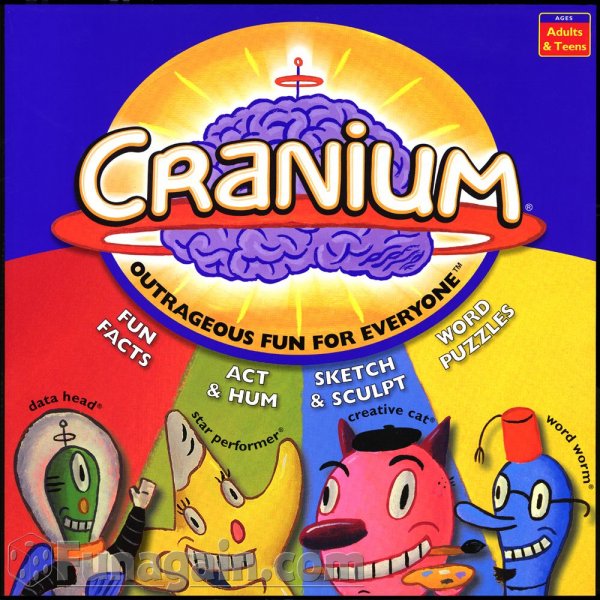

Typically, when we cover cooperative board games here at Tabletop Co-Op, we look at recent games, and typically those that are highly thematic and deep strategically. Today, we consider a game that is a bit older, non-thematic, and devoid of any sort of strategy or tactics. Cranium Hoopla may be different from what we normally discuss here, but it’s still a lot of fun and certainly worthy of our attention.
While I have been a board game fan for most of my life, it is only in the past decade or so that my game closet has become overstuffed. Before the explosion in (for lack of a better term) “designer” board games in the past decade or so, I mostly played the classics that everyone is familiar with. As the 20th century turned into the 21st, a new game came out, and hooked me, my friends, and my family. That game was Cranium, and it quickly became the most-played game at my house.
Cranium is in essence a party game, but a clever one. It borrows concepts from a variety of games and mashes them all together into something not exactly new, but different. Players work in teams, racing around the board in order to finish first, like many, many other games. The spaces players land on determine what type of activities they need to complete as a team. The conceit is that Cranium has activities that appeal to everyone; every brain type will find something here they can excel in.

Creative Cat activities require you to, erm, create something. Typically, it’s a sketch (a la Pictionary) but sometimes a purple clay sculpture. Trivia fans will enjoy Data Head spaces, where knowledge of random facts or at least good guessing skills are rewarded. Spelling and vocabulary skills will serve players well when they land on a Word Worm activity. Lastly, Star Performer spaces include things like charades, or humming a popular song. Purple spaces allow the team to choose whatever activity they are most familiar with.
That’s really all there is to it. It’s simple, but very fun. The variety of activities solves many problems that pop up in party games. Different people enjoy different things, and by including something for everyone, Cranium is an excellent choice that will satisfy everyone’s particular taste. We probably played Cranium a hundred times or more, buying new editions with more cards and enjoying every minute of it.
However, there is one big problem with Cranium, and that is the head to head nature of the game. In the end, one team wins, while the others lose. For highly competitive groups, this can be a major issue. I have seen accusations of cheating, bad winners, sore losers, and all manner of arguments, just because people get so involved in the game that they forget that fun is the goal, not winning. The game can go long, as well, particularly if teams get stuck for too long on an unfun (for them) activity.
The answer to this problem is Cranium Hoopla. Hoopla is similar to the original Cranium, but changes things up enough to make it its own entity. Players have a hand of four cards, each with a picture of a Who, What, or Where. Players roll a die to determine which activity they will use to get the others to guess one of their cards. There are four different types of activities, each of which will serve a particular type of player. Sketching and charades from Cranium appear alongside Tweeners, where you describe something as “smaller than _____, but larger than _____”, and Tongue-Tied, where you use alliteration to make your point.
The cooperative aspect comes in beating the timer. The goal is to get through your hand, as well as a stack of eight cards, before time expires. The timer lasts for fifteen minutes, which means you can’t spend too long on any one card. If no one guesses your card, you have to draw another as a penalty. Cards guessed correctly are added to a “Hall of Fame” stack, and play proceeds to the next player. Like Cranium, it sounds simple but is deceptively difficult and very, very fun.
Cranium Hoopla isn’t an exact replacement for the original game, but it generally scratches the same itch. It fixes many issues in Cranium, too. Everyone gets involved, is cooperating, and having a good time. It also takes far less time to play, and doesn’t ever get frustrating. I look back on Cranium fondly, but Hoopla is really a far better party game. I’m not aware of any other party games that are as cooperative in nature, making Hoopla unique.
Sadly, Cranium Hoopla is out of print, and hasn’t been on store shelves for quite some time. All of the Cranium games were fairly popular, meaning Hoopla had a good sized print run, and thus it is fairly easy and inexpensive to pick up a copy on Ebay, or even at your local thrift store or a garage sale. If you are looking for a quick-playing, fast-paced cooperative game to bust out at your next get together, Cranium Hoopla is a fine choice.